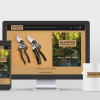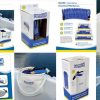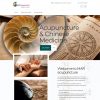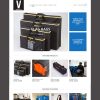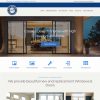Are you trying to increase website traffic but aren’t seeing the results you want? This guide will teach you how to optimize your website for conversion so that you can start seeing more traffic and ROI.
What is conversion rate optimization?
Conversion rate optimization (CRO) is the process of improving the percentage of visitors to a website who take a desired action. This action could be anything from making a purchase to signing up for a newsletter. CRO can be used to increase the number of conversions on your website or app, and improve the overall effectiveness of your website or app.
SEO is the process of optimizing your website for search engines in order to improve your ranking. From a marketing perspective, SEO can boost traffic and increase sales. From a design perspective, it optimizes the user experience on websites by making sure that everything loads quickly and without issues. Today I want to talk about how you as an individual blog owner can optimize your own site so it converts visitors into leads or customers!
What are the benefits of conversion rate optimization?
- Intro hook: Conversion rate optimization (CRO) has distinct benefits for SEO, including improved customer insights, better ROI, and scalability.
- Improved customer insights: CRO can help you better understand your key audience and find what language or messaging best speaks to their needs.
- Better ROI: Higher conversion rate means making more of the resources you have (such as acquisition efforts).
- Better scalability: Audiences aren’t infinite – CRO lets you grow without running out of resources and prospective customers.
- By turning more browsers into buyers, you’ll be able to increase your customer base without running out of potential customers.
- Better user experience leads to increased engagement and evangelism: When users feel smart and sophisticated on your website, they tend to stick around longer. CRO studies what works on your site and expands on it, making a better user experience for all visitors. This results in increased engagement and evangelism for your brand.
- Enhanced trust leads to increased shareability: In order for a user to share their credit card, email address, or any sort of personal information with you, they have to genuinely trust the site – which is why a good CRO ensures that your website is professional, courteous and ready to answer all of their questions.
- “Number-one salesperson”: Your website is the number-one salesperson for your business – just like an internal sales team should be! It needs to be professional, courteous, and ready to answer all customer’s questions in order for them to use it as their go-to source for information about what you do.
Emediacy is a digital marketing agency that can help to attract, engage and convert your audience. Emediacy’s experts will work with you to develop a custom CRO marketing plan and show you how important it is to your company’s online success.
Through paid advertising and advanced SEO strategies, Emediacy has helped businesses in generating leads, increase conversions, and raise brand awareness. To know how Emediacy can help to grow your business exponentially, schedule a consult today.
Conversion Rate Optimization Strategies
1. Create text-based CTAs within blog posts.
Banner blindness can make CTAs ineffective, so a text-based CTA is a better option.
Banner blindness means people become accustomed to ignoring banner-like information and don’t always read all the way to the bottom of a blog post.
To be effective, CTAs need to be in text form and not in the form of banners.
Text-based CTAs convert more leads than regular CTAs.
Text-based CTAs generate more leads by targeting anchor text alone, rather than relying on banner ads.
Banner blindness is a phenomenon where website visitors do not take the desired action because they do not see the banner. One way to overcome this is to use a text-based CTA instead of a banner. Text-based CTAs are more effective than regular CTAs because they are more visible and easy to read.
2. Add lead flows on your blog.
Lead flows are high-converting pop-ups that can be used to attract attention and offer value. Slide-in boxes, drop-down banners, or pop-up boxes can be used to create lead flows. Slide-in boxes have been shown to have a higher clickthrough rate and more submissions than a regular CTA at the bottom of a blog post.
Lead flows are high-converting pop-ups that attract attention and offer value. Slide-in box lead flows perform better than drop-down banners or pop-up box lead flows.
Lead flows can be used to increase conversion rates by offering a value proposition that is relevant to the user and by making the lead flow easy to dismiss if the user is not interested.
3. Run tests on your landing pages.
A landing page is a page on your website where you can test different aspects of your site. This could include testing different copy, offers, images, form questions, or web pages. By changing these elements on your landing page, you can see what works best for your audience.
For example, China Expat Health increased its lead conversion rate by 79% simply by changing its headline from “Health Insurance in China” to “Save Up to 32% on Your Health Insurance in China.” A/B testing is a quick and easy way to test different versions of your landing page so that you can optimize it for the best results.
A landing page is a web page that allows you to collect leads or signups. You can test a landing page by running A/B tests to see what design and content features work best for your audience. By testing different versions of your website, you can increase conversion rates and determine which elements are most successful in converting leads.
4. Help leads to immediately become a marketing-qualified lead.
A marketing-qualified lead is a lead that has been determined to be more likely to convert into a paying customer. There are a number of factors that can help contribute to a lead being qualified as marketing-qualified, including their level of engagement with your brand, the types of content they’re interested in, and whether they’ve shown an interest in your product or service.
There are a few key things you can do to help turn leads into marketing-qualified leads. One is to design web pages that encourage visitors to sign up for product demos. This can be done through the use of clear and compelling copy, as well as effective calls-to-action (CTAs). Additionally, you’ll want to make sure your website and overall conversion path are optimized in order to reduce friction and increase the likelihood that leads will take the desired action.
A marketing-qualified lead (MQL) is a lead that has been determined to be more likely to convert into a customer, based on certain criteria set by marketers. To help leads become marketing-qualified leads, you can encourage them to take specific actions such as signing up for product demos.
Creating web pages that are thoughtfully designed and compelling can also help increase conversion rates. Additionally, it is important to optimize your website and conversion paths for marketing-qualified leads. This means focusing on the processes that are most likely to generate customers.
5. Build workflows to enable your team.
Workflows are a series of processes that are completed in order to achieve a goal. In the context of conversion rate optimization, workflows can help to automate processes and ensure that all steps involved in a conversion process are completed correctly and in a timely manner. By doing so, workflows can help to streamline conversion processes and make them more efficient. In turn, this can help to improve conversion rates.
Workflows help to automate common tasks related to conversion rate optimization. This can include emailing leads, sending meeting requests and reminders, and even abandoned cart emails. Automating these processes can help ensure consistency and quality across your website, which can lead to a higher conversion rate.
6. Add messages to high-converting web pages.
High-converting web pages are pages that are designed to encourage visitors to take the desired action, such as making a purchase or signing up for a newsletter. To make a page more likely to convert, you can add messages that focus on the user’s conversion goals.
For example, you can add a message on pricing pages that offers discounts for signing up for a newsletter, or on product pages that offers customer support. You can also make your chatbots action-based so that when someone spends a long time on a page, you offer to help them out automatically.
High-converting web pages are those that encourage visitors to take a desired action, such as making a purchase or subscribing to a service. To increase the chances of conversion, it is important to add relevant and targeted messages to these pages.
Live chat software can be used to great effect on high-converting web pages. By offering support and guidance in real-time, live chat can help increase conversions by providing lead information in real time. Additionally, live chat can be used to automate tasks that would traditionally require help from other teams, such as offering help to customers who have spent a long time on the page.
7. Optimize high-performing blog posts.
If you have blog posts that are receiving a high level of web traffic but have low conversion rates, there are some potential issues that you can look for. SEO issues, content that is promoting a different offer, or poor CTAs can all lead to low conversion rates.
To increase conversion rates, focus on optimizing your blog posts for the search engine results page. Keep your blog posts fresh and relevant by optimizing them for the SERP. This will help ensure that potential customers are seeing your most up-to-date and relevant information when they search for topics related to your business.
To optimize blog posts for conversion rate optimization, identify your posts with the highest levels of web traffic but low conversion rates. Try to improve the SEO, content offer, or CTA of these posts. Update your blog posts as needed to ensure they’re fresh and relevant.
8. Leverage retargeting to re-engage website visitors.
Retargeting is a method of online advertising that allows businesses to show ads to people who have already visited their website. This is done by placing a piece of code on your website, which then enables you to serve ads to those same visitors as they browse the internet. Retargeting can be used to improve website conversions because it allows businesses to show relevant ads to people who are already interested in their product or service.
Retargeting is a way to reach people who have already shown an interest in your product or service. By targeting ads specifically to these individuals, you can improve your website’s conversion rate. United used insights from past campaigns to create a targeted ad campaign that was a huge success. YouTube ads are another great way to target potential customers and convert them into customers. CRO (customer Retention Optimization) can also be used to improve website conversion rates.
Emediacy is a digital marketing agency that can help to attract, engage and convert your audience. Emediacy’s experts will work with you to develop a custom CRO marketing plan and show you how important it is to your company’s online success.
Through paid advertising and advanced SEO strategies, Emediacy has helped businesses in generating leads, increase conversions, and raise brand awareness. To know how Emediacy can help to grow your business exponentially, schedule a consult today.
What are the 6 primary elements of conversion rate optimization?
Conversion rate optimization is the process of increasing the percentage of visitors to your website who take a desired action, such as making a purchase or signing up for a newsletter. The six primary elements of conversion rate optimization are:
1. A/B Testing: This involves testing different variations of your copy to see what works best to increase conversions.
2. Customer Value Proposition: This is the part of your copy that shows visitors why they should buy from you and how your product or service will benefit them.
3. Simple Language: Use clear and concise language in your copy so that it is easy to understand and not overwhelming.
4. Urgency: Creating a sense of urgency can encourage visitors to take action right away so they don’t miss out on a great deal.
5. Concerns: Be sure to address any concerns that potential customers may have so they understand what they need to do to complete the purchase and have their questions answered.
6. Call to Action: Make it easy for visitors to take the desired action with a clear and effective call to action button or link.
Who is conversion rate optimization useful for?
Conversion rate optimization is beneficial for businesses of all sizes and industries as it can help improve conversion rates and achieve desired results. By optimizing the overall user experience of a website, businesses can increase the likelihood of website visitors taking the desired action, whether it be making a purchase, signing up for a newsletter, or filling out a contact form.
Start increasing conversions today
To increase website conversions, you need to A/B test your copy to find the best conversion rates. You should also craft a powerful customer value proposition that resonates with your audience. Additionally, use simple language that is easy to understand, create urgency to make your customer take action, and address your customer’s concerns and remove them.
What increasing your conversion rate really means
A conversion rate is the percentage of visitors to your website who take the desired action (e.g. subscribing to your newsletter, or making a purchase).
There are a few things you can do to increase your conversion rate:
1. Optimize your website’s design and content. Make sure your website is easy to navigate and that your content is relevant and engaging.
2. Use effective calls to action. Tell visitors what you want them to do, and make it easy for them to take that action.
3. Offer incentives. Give visitors a reason to take the desired action, such as a discount or free shipping.
4. Test different versions of your website and track the results. Try different designs, call-to-action text, and offers until you find what works best for your business
What are some common in-depth guides for CRO?
Conversion rate optimization (CRO) is the process of optimizing a website to drive more conversions. The goal of CRO is to increase the percentage of visitors who take a desired action, such as making a purchase or subscribing to a newsletter.
There are many different techniques that can be used to improve conversion rates, but some of the most common include A/B testing, personalization, and creating compelling landing pages.
A/B testing involves creating two versions of a web page and then testing which version performs better in terms of conversion rate. This can be done by split-testing, which means randomly showing each version to different visitors, or by multivariate testing, which tests different combinations of elements on a single page.
Personalization is another effective CRO technique and involves showing different content or offers to visitors based on their location, interests, or other factors. This can be done using cookies to track user behavior and then displaying relevant content accordingly.
Creating compelling landing pages is also key to driving conversions. A landing page is the first page that a visitor sees when they arrive at your website and it should be designed to encourage them to take a desired action. This means including strong calls-to-action and relevant, compelling copy.
By following these tips, you can optimize your website for conversion and drive more sales and leads.
How can you get started with CRO?
Conversion rate optimization (CRO) is the process of increasing the number of conversions from your website or online marketing campaigns. The PIE framework can help prioritize your efforts by ranking each element on Potential, Importance, and Ease. Once you’ve assigned a score for each strategy, add up the numbers and divide the total by three to give a score that shows what project will have the greatest impact.
Emediacy is a digital marketing agency that can help to attract, engage and convert your audience. Emediacy’s experts will work with you to develop a custom CRO marketing plan and show you how important it is to your company’s online success.
Through paid advertising and advanced SEO strategies, Emediacy has helped businesses in generating leads, increase conversions, and raise brand awareness. To know how Emediacy can help to grow your business exponentially, schedule a consult today.



